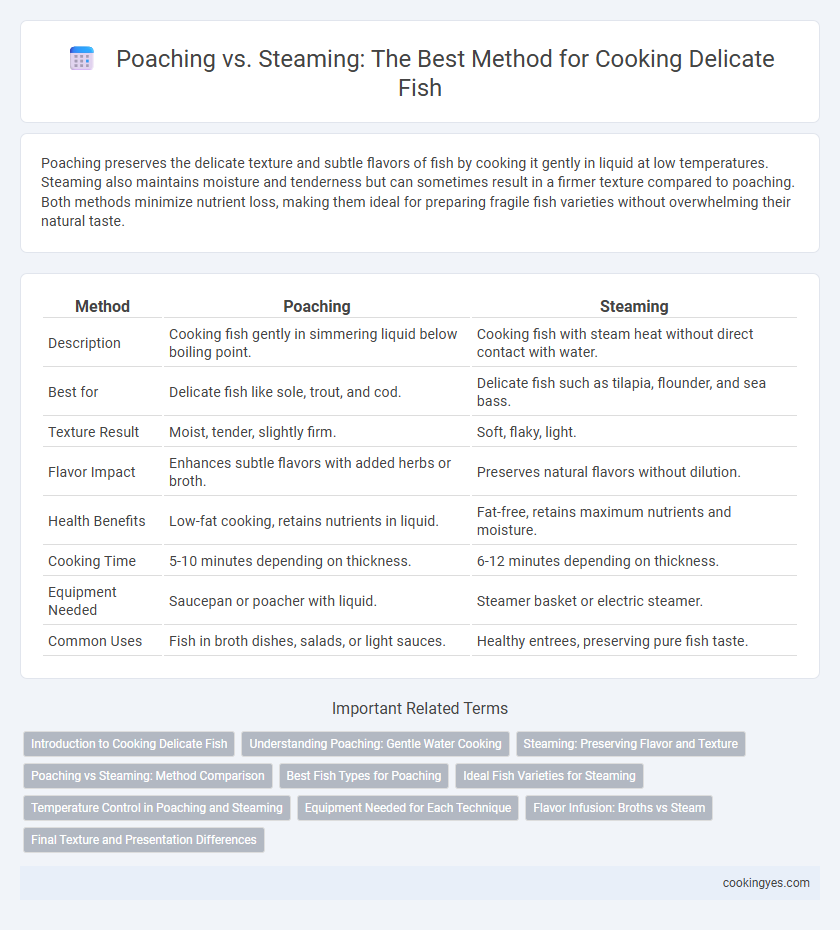Poaching preserves the delicate texture and subtle flavors of fish by cooking it gently in liquid at low temperatures. Steaming also maintains moisture and tenderness but can sometimes result in a firmer texture compared to poaching. Both methods minimize nutrient loss, making them ideal for preparing fragile fish varieties without overwhelming their natural taste.
Table of Comparison
| Method | Poaching | Steaming |
|---|---|---|
| Description | Cooking fish gently in simmering liquid below boiling point. | Cooking fish with steam heat without direct contact with water. |
| Best for | Delicate fish like sole, trout, and cod. | Delicate fish such as tilapia, flounder, and sea bass. |
| Texture Result | Moist, tender, slightly firm. | Soft, flaky, light. |
| Flavor Impact | Enhances subtle flavors with added herbs or broth. | Preserves natural flavors without dilution. |
| Health Benefits | Low-fat cooking, retains nutrients in liquid. | Fat-free, retains maximum nutrients and moisture. |
| Cooking Time | 5-10 minutes depending on thickness. | 6-12 minutes depending on thickness. |
| Equipment Needed | Saucepan or poacher with liquid. | Steamer basket or electric steamer. |
| Common Uses | Fish in broth dishes, salads, or light sauces. | Healthy entrees, preserving pure fish taste. |
Introduction to Cooking Delicate Fish
Poaching preserves the delicate texture of fish by cooking it gently in simmering liquid, maintaining moisture and subtle flavors ideal for fragile fillets like sole or flounder. Steaming uses steam heat to cook fish evenly without direct contact with water, retaining nutrients and preventing the fish from becoming mushy. Both methods enhance the natural taste and tenderness of delicate fish, making them preferred techniques over high-heat cooking.
Understanding Poaching: Gentle Water Cooking
Poaching involves gently cooking delicate fish at low temperatures, typically between 160degF and 180degF, often in water, broth, or wine, to maintain moisture and tender texture. This method preserves the fish's natural flavor and prevents the protein from becoming tough compared to steaming, which uses vapor heat and can sometimes overcook thinner fillets. Mastering poaching techniques ensures delicate fish remains flaky, moist, and subtly infused with aromatics without compromising its nutritional value.
Steaming: Preserving Flavor and Texture
Steaming delicate fish preserves its natural flavor and tender texture by gently cooking it through moist heat without direct contact with water, which prevents nutrient loss and maintains moisture. This method enhances the fish's subtle taste and delicate flakiness, making it ideal for species like cod, sole, and flounder. Compared to poaching, steaming minimizes flavor dilution and helps retain the freshness and intrinsic oils that contribute to a superior culinary experience.
Poaching vs Steaming: Method Comparison
Poaching gently cooks delicate fish by submerging it in simmering liquid, preserving moisture and preventing overcooking, which maintains the fish's tender texture and subtle flavor. Steaming uses indirect heat to cook fish through vapor, offering a low-fat, nutrient-retaining method that keeps flesh firm while enhancing natural taste. Both techniques provide healthy cooking options, but poaching excels in infusing flavors from the cooking liquid, whereas steaming better preserves the fish's original appearance and nutrients.
Best Fish Types for Poaching
Poaching is ideal for delicate fish such as sole, flounder, and cod due to its gentle cooking method that preserves moisture and texture without breaking the flesh. Steaming also maintains tenderness but is better suited for slightly firmer fish like salmon or trout. For optimal results, poach lean, mild-flavored fish to enhance subtle taste and ensure even cooking.
Ideal Fish Varieties for Steaming
Steaming is ideal for delicate fish varieties such as cod, sole, halibut, and flounder, as it preserves their tender texture and subtle flavors better than poaching. These fish have mild flavors and flaky flesh that benefit from steaming's gentle heat, which helps retain moisture and nutrients without causing the fish to break apart. Steaming also minimizes nutrient loss, making it a healthier cooking method for sensitive white fish and lean species.
Temperature Control in Poaching and Steaming
Poaching fish involves submerging it in gently heated liquid, typically maintained between 160degF and 180degF, ensuring even cooking without overexposure to high heat, which preserves delicate textures. Steaming uses moist heat at consistent temperatures around 212degF, offering a uniform cooking environment that prevents drying while maintaining the fish's natural moisture. Precise temperature control in poaching allows for subtle flavor infusion, whereas steaming excels in retaining the fish's structural integrity and nutrient content.
Equipment Needed for Each Technique
Poaching delicate fish requires a shallow pan or skillet with a lid, a gentle heat source, and flavorful poaching liquid such as stock, wine, or water infused with herbs. Steaming needs a steamer basket or rack, a covered pot or steamer appliance, and consistent boiling water to create the necessary steam without direct contact with the liquid. Both methods demand precise temperature control, but steaming equipment often offers a gentler, more even cooking environment ideal for maintaining the fish's texture.
Flavor Infusion: Broths vs Steam
Poaching delicate fish in flavorful broths allows the fish to absorb subtle nuances from herbs, spices, and aromatics, resulting in a richer taste experience. Steaming, however, preserves the pure, natural flavor of the fish by gently cooking it with moist heat without diluting its essence. Both methods enhance texture, but broths contribute complex layers of infused flavor, while steaming emphasizes freshness and delicacy.
Final Texture and Presentation Differences
Poaching delicate fish results in a tender, moist texture with a silky, gently cooked appearance that retains the fish's natural shape, ideal for elegant plating. Steaming produces a slightly firmer texture with a clean, translucent finish, preserving vivid color and subtle flavors while offering a more structurally intact presentation. Both methods prevent overcooking, but poaching allows for more infused flavors in the final dish, whereas steaming emphasizes purity and freshness in texture and visual appeal.
Poaching vs Steaming for delicate fish Infographic

 cookingyes.com
cookingyes.com